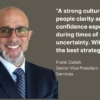
By Heather Wood
Strong and purposeful communication is an important tool for managers and leaders alike. The transition to a hybrid workforce has made thoughtful communication even more important. When scheduling a team meeting or one-on-one think about the three C’s: Communication, Clarity, and Compassion. Consider how much information you are sharing (frequency, volume, relevance to the audience), be sure to check in with your audience to make sure they understand what’s being said or asked of them and try to remember that more than ever our teams are tethered to their computers yet still have obligations at home to take care of. Be sure you are looking for and seeing the human aspect of your team.
As we enter the last month of the 1st quarter of 2022, one thing is clear; with new COVID variants appearing on a regular basis, hybrid working arrangements – time spent working from home, time in the office – have become the norm. And, while we’ve learned a lot in the past two years as managers, it’s valuable to step back for a moment, consider lessons learned and maybe even pick up some new ideas on how to best manage a hybrid workforce.
The Three C’s: Communication, Clarity, and Compassion
What do your direct reports and colleagues require most from you? It depends. Each person is an individual in their own right, with a unique personality, working style and life desires. Each individual needs effective communication from their manager and others, clarity on the work to be done, and especially compassion because we are still in the midst of a pandemic, now a war in Ukraine, and all the uncertainty that this brings.
Communication: Quality and Quantity
It’s easy to get wrapped up in your own “to do” list, hopping from video call to video call, answering emails and texts and team messages. Sometimes it feels like we have too much communication!
Think quality and quantity when planning how you communicate with your team and individual employees. What does each person desire? How often do you require a one-on-one? What do you want to discuss in these chats? How often does the team need to meet? How can you make sure your team meetings are effective?
The value of chatting. Americans tend to get right to the task at hand and save the small talk for later (if ever). But with so many employees working remotely, those little chats become even more important. If we were all in a shared physical space it would happen more naturally. Bumping into co-workers in the kitchen or cafeteria. Walking by someone’s desk and stopping to say hello and checking in. These spontaneous and human communications are the mortar that holds a team together and makes employees feel connected to their organization.
In a hybrid work environment, we have to make the time for “how are you doing” communication. Again, think of each direct report. What does that person need? Maybe they are new to the organization, or to the role, and need more frequent check-ins. Ask them how they are doing, how are things in their lives, in addition to what support they need, stressing that you want to assist them in any way you can.
In video team meetings, don’t rush immediately to the agenda. While waiting for attendees to arrive, encourage chit-chat. Start your meeting with a check-in: what’s one word that describes your weekend, or the weather right now? Or one word that describes your approach to 2022?
The value of meeting structure. Now might be a good time to refresh your meeting management skills. We all fall into routines, some good and some not so good. Examine how your meetings are going. What is preventing them from being more effective? What is working well?
Here are some ideas for strengthening your meeting facilitation skills. What could you add to your skill set?
Establish meeting norms. For example, “We all agree to…”
- Camera on. Make it an expectation that everyone will attend via video whenever possible. When some attendees are on camera and some aren’t, there is an asymmetry.
- Phones put away or on silent.
- Adhere to the agenda. If there’s a topic taking the meeting off the agenda, everyone is empowered to speak up and suggest another time or place to work on the issue.
- Start and end meetings on time. This shows respect for everyone’s time.
- Begin with a check-in and end with check-out. What did we all just agree to? When are we meeting next? What did we just decide, and who’s doing what?
- Leave 10 minutes before the next meeting. Have time to take a breather, a small break, and to prepare for your next call/meeting
Manage participation. Just like an in-person meeting, meeting facilitators have a responsibility to make sure everyone has the chance to share their thoughts and to participate. Watch out for “dominators” or “ramblers.” If someone is taking up too much talk time, respectfully acknowledge their comments, and then “turn” to others in the meeting who haven’t given input like the introverts or the multitaskers.
Use technology to your advantage. Many of our video calls involve just a few people. But sometimes you need to pull a large group together to examine an issue and get input. Getting full participation in that situation can be difficult. Most video software offers the ability to create break-out groups. With only a handful of participants, pose a question or topic and ask them to spend 5-7 minutes to discuss. You can even “visit” each break-out group and listen. Then bring everyone back together and ask each group to report back the main points.
Actively listen. Video calls are an improvement over phone calls. We get a lot more information, both verbally and non-verbally. But we’re still sitting in front of a computer. So, we need to adapt our active listening skills to the video environment, adding more conscious physical movement. Respond non-verbally with a smile or nod. Be aware of your facial expressions. Move closer to the camera to show you are really listening to the person speaking or when it’s your turn to speak. Then sit back. Pay attention to where people place the emphasis in their words and interpret the meaning. It can also be easier to connect with the person speaking if you choose the “speaker” view instead of the “gallery” view in your video software.
It’s not easy but do not be hesitant to have a different or dissenting position. Healthy conflict in a virtual or hybrid environment is just as important as when everyone is together in-person. Share your views, challenge the status-quo, ask why or why not; suggest new ways or ‘out of the box’ approaches. Creativity and innovation need to flourish in a remote and hybrid environment as well.
Clarity: Meet the Need
We all have different styles. Some of us are more direct, others more subtle. Some of us need structure and rules; others are more comfortable with “winging it.” Ask yourself: do you need a clear and well-defined path, or are you a “we’ll figure it as we go along” kind of person?
However, one thing we have in common is the need to know what is expected of us. Think about your employees and peers. What do they need and how do they need it delivered? If you’re a “wing it” kind of person managing a “I need a plan with clear deadlines and measure of success” person, you’ll need to adjust. One way to discover what your people need is to simply ask for their preferences around communication, for instance, how often they want to check in and questions they have.
Be available. Create office hours, virtual and in-person, and communicate those to the team. Set up a virtual room on Zoom, Microsoft Teams, Slack, etc. Set up a space in the office for people to safely join you when in-person. Commit to being there! Truly have an open-door policy. If someone needs an ad-hoc check-in and you’re busy, agree when to re-connect so they know support is imminent.
Tap into your inner grace, patience, and empathy. When a team member comes to you asking for clarity, provide it. Even if you feel you’re being repetitive. People are overwhelmed and details may be muddled. Take a deep breath, answer the question, and tactfully ask them to repeat what you just said. It may feel elementary but they’re coming to you because they need your support. Meet people where they’re at.
Compassion: What I know right now is this…
We’ve been living in this chaotic world for two years. People are tired, even exhausted, from the uncertainty, the constant change. How many times can you “turn on a dime” before getting dizzy? That’s why compassion for others – and yourself – is crucial.
All we know is…what is at this moment. As a manager, take the heat off yourself occasionally and remember that you can’t predict the future, you can only help your people in the present. You don’t have all the answers. Who could? Listen to your employees, hear their frustration, be compassionate and show empathy, but don’t think you can cure it all. This phrase is useful for framing your response: “What I know right now is this…”. For example, “What I know right now is that we won’t be back in the office until next month…” “What I know right now is that we have approval to hire freelance help…”, “What I know right now is employees can use any paid-time-off days regardless of accrual,” etc.
Watch out for burn out. Many of us spend our days staring at a camera. While it’s natural to want to meet coworkers to get things done, truthfully, it’s wearing people down. It’s not just a video call; it’s yet another meeting where one is expected to be fully attentive and “on.” Keep this in mind when scheduling video calls. Ask yourself, what is the best way to accomplish the goal? Could a quick phone call with the person work better? If the communication doesn’t need to happen in synchronous time, use a collaboration tool instead of a video call. Workers are juggling many demands right now including family and personal needs. If they can collaborate asynchronously with their coworkers, then it’s easier to work around other commitments, like picking the kids up from school.
Pay attention to the unspoken expectations. Every workplace has cultural norms that set the tone for how work gets done. What was the time/date stamp on the email you sent? Are you trying to prove to your managers and colleagues that you’re on top of things, even late at night? If you’re doing this, then you can bet your direct reports know it, which can put more pressure and stress on them. You might send an email to your employees during non-work hours, and even tell them they don’t have to respond, but most people are never more than a foot away from their phones. When the boss texts you at 9:30 pm, it’s hard to ignore it, and they may worry that if they don’t respond, it will look bad. Compose the email but wait until the morning to send it.
You’ve probably read many articles like this during the pandemic, with lots of tips on taking breaks, relaxing, getting good sleep, eating right, exercising, etc. It’s easy, though, to be compassionate to others but still hard on yourself. Empathy, however, begins within you. It means recognizing and owning up to your own struggles. This enables you to truly understand what an employee may be going through. It will also help you be a role model to them on how to handle the ups and downs and make it easier for them to reach out to you when they need help.
About MCG Partners
MCG Partners a woman-owned, Greater Boston-based consultancy specializing in executive coaching, leadership development, talent management, and organizational development solutions. We help businesses optimize success through the entire management life-cycle. MCG Partners is also a Predictive Index® (PI®) certified partner.
To learn more about MCG Partners’ services or The Predictive Index®, contact John Griffith at stephanie.holmgren@mcgpartners.com or at www.mcgpartners.com









